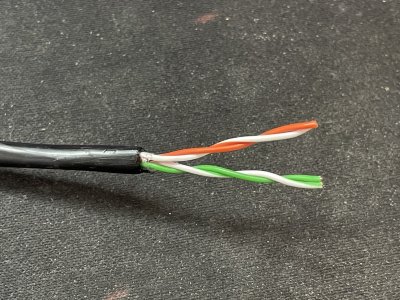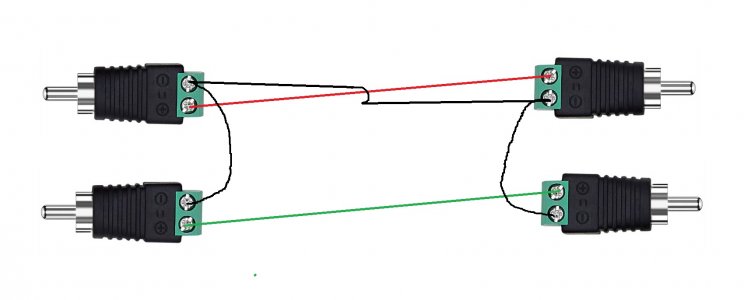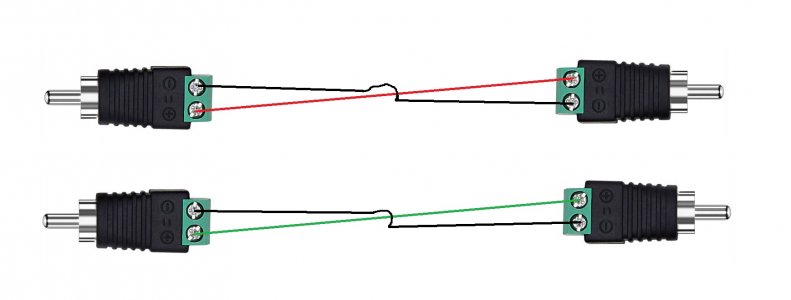You are using an out of date browser. It may not display this or other websites correctly.
You should upgrade or use an alternative browser.
You should upgrade or use an alternative browser.
RCA interconnect cable (pair) ground connection question.
- Thread starter sim_tcr
- Start date
electrically both will work. The bottom one is prefered because you can twist the wires to elminate EMI. The bottom configuration will also work for independent mono blocks which have no common ground connection between them.
spirovious
Well-Known Member
Yes it can be used. I have tried it But if you keep separate ground for each channel ,it may better to keep noise or mixingHello,
When making DIY RCA interconnect cable (pair), can a single ground wire be used for left and right or a dedicated ground wire for each?
I am attaching drawings.
View attachment 73037
View attachment 73038
availlyrics
Well-Known Member
- Joined
- Sep 26, 2011
- Messages
- 348
- Points
- 63
2nd scheme is preferred to avoid ground loop and noise, use shielded wires
follow the advice given above and go with the 2nd configuration. Use closely twisted pair cables, you can also hack any ethernet cable and use two of its pairs, if needed untwist and retwist them closely.
If you are not twisting and use straight wires, the jacket them with a simple cotton cloth to prevent sagging.
But twisted is the logical way to go.
Also, if you are using the above type of connectors (they are called baluns), then be very careful as the +ve and -ve being very close, it can lead to short and blow your equipment. ensure that there are no stray wires at the connection points. If possible solder the ends before screwing-in.
If you are not twisting and use straight wires, the jacket them with a simple cotton cloth to prevent sagging.
But twisted is the logical way to go.
Also, if you are using the above type of connectors (they are called baluns), then be very careful as the +ve and -ve being very close, it can lead to short and blow your equipment. ensure that there are no stray wires at the connection points. If possible solder the ends before screwing-in.
follow the advice given above and go with the 2nd configuration. Use closely twisted pair cables, you can also hack any ethernet cable and use two of its pairs, if needed untwist and retwist them closely.
If you are not twisting and use straight wires, the jacket them with a simple cotton cloth to prevent sagging.
But twisted is the logical way to go.
Plus 1 to this. Twisting will cancel emi and contribute a lot towards reducing noise pickup
@sim_tcr When using baluns, the strands will break in the exposed section after the insulation ends and the portion where it is inserted in the balun. This is because metal wires are ductile and malleable. when you bend any metal wire back and forth, it gets thinner and thinner at the bend and ultimately break. When movement the strands will break. With such a configuration I usually do the followingAlso, if you are using the above type of connectors (they are called baluns), then be very careful as the +ve and -ve being very close, it can lead to short and blow your equipment. ensure that there are no stray wires at the connection points. If possible solder the ends before screwing-in.
1) Tin the exposed strands at both the ends using a soldering rod.
2) Insert the tinned wire as much as possible so that the wire is totally inside but the insulation is just outside.
3) After you have tightened the screws, pour molten wax so that the holes are totally covered and you can clearly see the insulated portion inside the wax
After you to the above any movement (when you fiddle with the wires) will not happen in the exposed section but will happen on the insulated section. This is a kind of strain relief and will go a long way in not having the wires break at the balun ends. I hope you have understood what I am saying.
Strain Relief
This definition explains the meaning of Strain Relief and why it matters.
@Kannan @mbhangui
I found some old ethernet cable which only has 2 twisted pairs inside (I don't know why) and for that reason the whole cable is thin and flexible.
Was thinking if I can use the cable as is, (Its already twisted inside the jacket). I will use only one pair for one RCA to RCA interconnect, other pair I will leave as is.

I found some old ethernet cable which only has 2 twisted pairs inside (I don't know why) and for that reason the whole cable is thin and flexible.
Was thinking if I can use the cable as is, (Its already twisted inside the jacket). I will use only one pair for one RCA to RCA interconnect, other pair I will leave as is.

why not, you can very well use them@Kannan @mbhangui
I found some old ethernet cable which only has 2 twisted pairs inside (I don't know why) and for that reason the whole cable is thin and flexible.
Was thinking if I can use the cable as is, (Its already twisted inside the jacket). I will use only one pair for one RCA to RCA interconnect, other pair I will leave as is.
View attachment 73147
Do you think this option is better than shielded coaxial cable?why not, you can very well use them
The length intended for the cable is maximum a feet.
That cable is for carrying two lines for telephones. My guess is that it will be copper. For audio frequencies that will have better conductivity than coaxial cables. That cable is most probably a CAT 3 cable.Do you think this option is better than shielded coaxial cable?
The length intended for the cable is maximum a feet.
The coaxial cables are mostly CCA (copper clad aluminium). For high frequencies (in MHz), the electricity flows on the outer surface due to skin effect. This implies for very high frequencies, having copper on the outer surface is as good as having the full conductor made of copper. This reduces the price of these cables without impacting the conductivity.
If you want to go with coax, go with those made for digital audio and not the usual TV type or antennae cables.Do you think this option is better than shielded coaxial cable?
The length intended for the cable is maximum a feet.
Also with coax cables, you cannot use thes type of Balun connectors
Mine is not for digital, but for analog (RCA interconnect).If you want to go with coax, go with those made for digital audio and not the usual TV type or antennae cables.
Also with coax cables, you cannot use thes type of Balun connectors
I have these Generic RCA Plug Gold Plated
This is a cat 3 cable. Notice that the twists on the pairs are not even so each pair will perform differently for noise rejection.@Kannan @mbhangui
I found some old ethernet cable which only has 2 twisted pairs inside (I don't know why) and for that reason the whole cable is thin and flexible.
Was thinking if I can use the cable as is, (Its already twisted inside the jacket). I will use only one pair for one RCA to RCA interconnect, other pair I will leave as is.
View attachment 73147
Use either only orange pair for both channels or green pair. Same for cat5 cables and above. All 4 pairs are twisted differently
All digital coax cables are excellent for analogue duty. The RG6 cable you have in the picture with those connectors are good as analogue cables.Mine is not for digital, but for analog (RCA interconnect).
I have these Generic RCA Plug Gold Plated
Buy from India's official online dealer!
Similar threads
- Replies
- 7
- Views
- 25K



